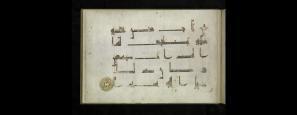About
The last four decades have witnessed significant progress in the scholarly understanding of the Qur’an. Nonetheless, contemporary scholarship is yet to produce a detailed historically oriented commentary on the entire Qur’anic corpus. Arguably the greatest interpretive, methodological, and expository challenges to this endeavour are posed by the long Medinan surahs found at the beginning of the corpus (Surahs 2–5). Reasons for this include their considerable length, their lack of an immediately apparent macrostructure, their frequent allusions to a great number of chronologically earlier Qur’anic proclamations, and the relative preponderance in them of legal and homiletic material, in addition to the narrative and eschatological registers familiar from many shorter surahs. Moreover, the Qur’an as a whole is punctuated by a great number of recurrent terms and phrases whose precise significance, contextual usage, and intimate correlations with earlier discursive traditions (the Bible, post-Biblical Jewish and Christian literature, and pre-Islamic Arabic poetry) remain to be fully and systematically gauged. The Medinan long surahs therefore constitute touchstones for the feasibility of any commentarial approach to the Qur’an as a whole: any exegetical protocol claiming to be capable of serving as a unitary framework for a full commentary on the Islamic scripture should first be demonstrated to be suitable to tackling these texts. Benefiting from the project team’s research into the Qur’an’s literary and compositional structure, Qur’anic law, and the Qur’an’s early reception history, QuCIP therefore aims to deliver crucial groundwork for a model historical-critical commentary covering Surahs 1–3, whose basic format could subsequently be extended to other parts of the Islamic scripture.
Towards a Historical and Literary Commentary on Surahs 1 and 2 (Nicolai Sinai)
By way of a first milestone, Sinai has produced an exegetical and intertextual dictionary of key Qur’anic terms and phrases that recur multiple times across the surahs in question and the remainder of the Qur’anic corpus (e.g., āmana, "to believe"; aslama, "to surrender"; āyah, "sign"; zakāh, "alms"; qalb, "heart"; dhakkara, "to remind"; khalada, "to remain forever"). Each entry consists of a short essay of up to c. 13,000 words discussing Qur’anic usage in addition to relevant evidence from pre-Qur’anic poetry, inscriptions, as well as Jewish and Christian traditions. Without such a dictionary, any commentary on the Qur’an would become hopelessly bogged down in constant digressions on particular terms and phrases, impeding any clear sense of literary progression in the surahs commented upon.
Based on this preparatory dictionary, Sinai has now begun work on a model commentary on at least Surahs 1 and 2 that integrates intertextual, theological, literary, and redaction-historical perspectives and, like the dictionary, critically draws on interpretive resources found in pre-modern Islamic Qur’an scholarship. Each surah commentary will follow a set template. An introductory overview discusses the respective surah’s compositional structure, date, and redactional development. A detailed verse-by-verse commentary including a new translation of the surah then provides a detailed and appropriately technical discussion of text-critical, lexical, grammatical, literary, redactional, and doctrinal issues.
In addition, the interlocking research of the QuCIP team will produce further articles and monographs:
Compositional Devices in the Qur’an (Marianna Klar)
Marianna Klar is researching the mechanisms by which the Qur’an defines its structural units and its thematic borders. Her publications as part of the QuCIP project explore, among other topics, the role that is played by shifts in rhyme and rhythm across otherwise unified expanses of Qur’anic text. Klar also investigates how specific surah sections are unified by recurrent diction and other devices. All of these matters are addressed from the working assumption that aspects of the Qur’an’s stylistics are comparable to other orally delivered texts such as the Psalms and pre-Islamic Arabic poetry. Drawing on the Qur’anic Adam narratives as a case study, Klar moreover examines the distinctive features of Qur’anic narrative against the background of other late antique literary traditions. Finally, Klar is working on identifying aspects of the Arabic rhetorical tradition that are apt to illuminate the modern literary study of the Qur’an.
Legal Paraenesis in the Qur’an (Nora K. Schmid)
Nora K. Schmid’s book project is devoted to legal paraenesis in the Qur’an, particularly in the Medinan surahs. Her research focuses on the question of how legal knowledge is formed, articulated, and imparted to the believers through exhortations and moral reminders. With a few exceptions, legal and quasi-legal passages in the Qur’an have so far mostly been studied without full regard to their rhetorical form and in isolation from their context. Here, by contrast, they will be approached as integrally linked to paraenesis and moral instruction. Based on the observation that the nexus of law and paraenesis is not unparalleled in late antiquity, Qur’anic legal paraenesis will be contextualized with Jewish and early Christian practices and ideas surrounding the transfer of legal knowledge and legal-ethical instruction. Topics to be studied against this background include paraenetic literary forms and tropes, their impact on the selection, organization, and disposition of legal material in the Qur’an, and the nascent Islamic community’s engagement with the process of legal-ethical decision-making as reflected in the Medinan surahs.
Hadith Literature as a Source for the Context of the Qur’an (Behnam Sadeghi)
The hadith literature is a significant yet underused source for understanding the origins and early interpretation of the Qur’an. However, the vastness and intricacy of the literature presents significant challenges. A single report may exist in dozens of versions, each transmitted through a different chain of transmission (isnād), thus implicating dozens of transmitters. Moreover, these individuals may have transmitted hundreds of other texts as well. Sadeghi’s work contributes to a better understanding of the individuals and communities engaged in transmitting reports about the Qur’an, its origins, its interpretation, and other topics. His research includes a study determining the demographic trajectories of the communities that were involved in hadith transmission. Sadeghi is also investigating the reception of the Qur’anic verses on menstruation during the first Islamic decades as attested by the hadith literature.



